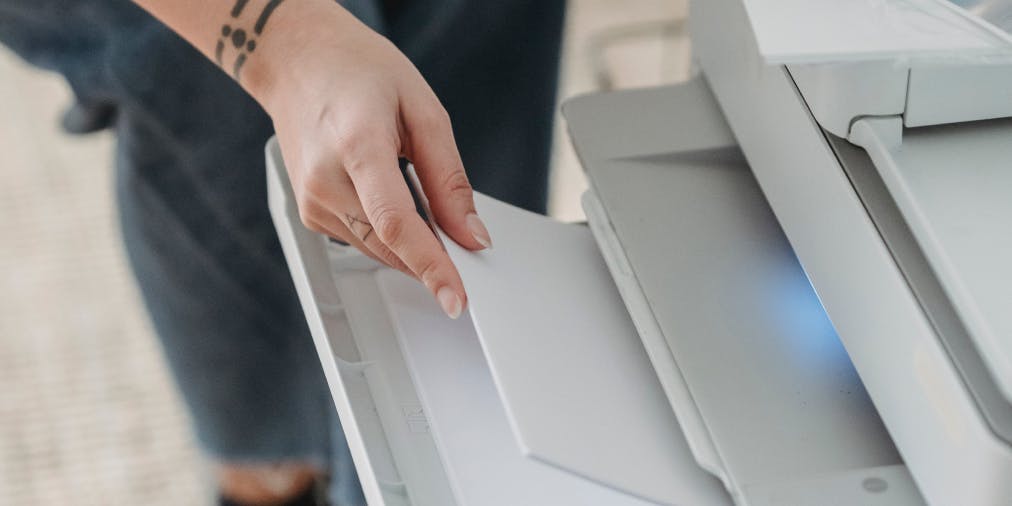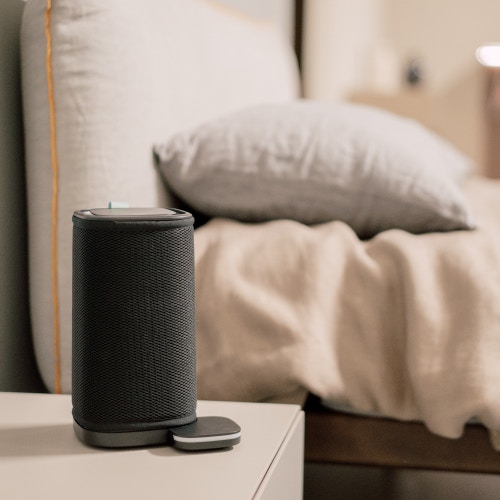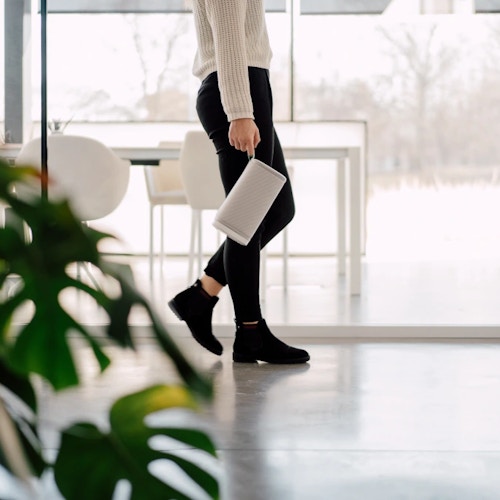
The effects of indoor air pollution in the office
→
Indoor air pollution in offices is a complex challenge that causes various effects on people. Let's find out how to overcome this problem!
Indoor air pollution in the office
What are the causes of indoor air pollution in the office?
- Flu and poor hygiene
- Printers and furniture
- Poor air circulation
- Detergents and cleaning products
- External sources such as pollen and vehicle exhaust gasses
Which are the effects of indoor air pollution in the office?
- Tiredness and discomfort
- Loss of concentration
- Decreased productivity
- Outbreak of respiratory diseases
How to prevent indoor air pollution in the office?
- Clean work areas frequently
- Air the rooms frequently
- Minimize the use of printers and use environmentally friendly furniture
- Change and properly maintain the ventilation system
- Purchase an air purifier
Air purifier: how it works and which one to choose
Vitesy, the company offering indoor air monitoring and purification solutions
Indoor air pollution in the office
Offices are by definition one of the places where workers spend a large part of their lives dedicating themselves to their profession, whether on their own or for a company.
They are the place where one goes to create, transform, confront and achieve the results and goals of one's profession.
The office must therefore be a place that allows those who work to feel at their best, protected and able to express their abilities in peace and security.
Unfortunately, however, it may not be so easy to ensure such an environment because of one major problem: the pollution of the indoor air that all workers breathe.
An invisible element that accompanies this environment throughout the day.
A problem that very often produces effects seemingly without cause, mistakenly thinking that this condition is simply due to the personal condition of the worker.
It is the WHO (World Health Organization) itself that makes us aware of the significance of this problem:
"Indoor air can be up to 5 times more polluted than outdoor air"
And this inevitably has an impact on people's working lives: breathing and our well-being are closely linked.
If we think about it, nothing is more essential than the air we breathe.
It is estimated that 1 in 3 workers have symptoms such as headaches, fatigue and general malaise due to Sick Building Syndrome an invisible condition that results from indoor air pollution in an enclosed place that does not have the right health conditions.
It is therefore easy to think that good air quality has a positive influence on our cognitive abilities and general health.
Conversely, poor air quality in our office will cause problems during our work activities.
But what are the causes? Why can it be so polluted? What are the factors that negatively influence indoor air quality in the office?
What are the causes of indoor air pollution in the office?
Indoor air pollution in offices can have many different causes and sources of which many are known, but many others are imperceptible or even invisible.
Flu and poor hygiene
Especially in winter periods, these two problems can be a primary source of pollution, making the environment unhealthy.
Seasonal viruses are inevitable and unfortunately, more or less, we all get sick with colds, sore throats or other respiratory inflammations.
Having to be shut in the same environment for a long time, the likelihood of becoming infected is inevitably very high, which is detrimental to the general well-being of all workers.
Another major problem is that infections of this type can be not only viral, but also bacterial.
Two problems that, if not properly controlled with the right precautions and proper hygienic behavior, can be the cause of workers being absent even for several days.
Printers and furniture
It seems absurd that seemingly harmless things like the work tools we use can themselves be a source of pollution, but this indeed is the case.

Moreover, the ink used is by no means natural and is mainly composed of chemical elements that are not in line with our health.
Even the desks we use can be a source of VOCs, especially formaldehyde (classified in high quantities as carcinogenic by the WHO).
Poor air circulation
Almost every office has an air recirculation system, which allows for renewed air flow in all rooms. But if not properly maintained, it can itself be a major source of bacteria and dust accumulation.
This is because ventilation areas are often left neglected because they are not directly visible or through sheer forgetfulness on the part of staff.
But it is important to take care of them to ensure continuous air recirculation, which can significantly help make the air less stagnant.
Detergents and cleaning products
Cleaning work areas is obviously essential and relevant to ensure proper hygiene and healthiness.
However, the recurrent use of chemical cleaners can be a sneaky accumulator of VOCs in offices. In fact, these products are very effective in cleaning and sanitizing work areas, but they have the great defect of containing substances that can irritate the respiratory tract if inhaled.
It is therefore a good idea to use them but to ventilate the room so that these substances vanish from the environment in which they are used.
External sources such as pollen and vehicle exhaust gasses
But in an office with polluted air, wouldn't it be sufficient to open the window to circulate an external air flow to clean the environment?
It sounds like a question that has an intuitive and easy answer, but unfortunately not!
Especially for offices based in large cities or metropolises, this could be a problem in the long run.
Because outdoor air can be a source of smog and particulate matter in busy areas.
Not to mention pollen, which for many allergic people is a real obstacle to breathing well.
What are the effects of indoor air pollution in the office?
The effects are diverse and very often one does not even realize that indoor pollution is the cause.
Tiredness and discomfort
That feeling that something is wrong and that we feel foggy, that we are not functioning at 100 per cent of our capacity.
Perhaps accompanied by a headache or more labored breathing than usual.
Indoor air pollution can very often be the cause, because polluted air means having less oxygen and above all introducing elements into our body that our organism has to dispose of by consuming various energies that are important to us throughout the day.
Therefore, it is not only the lack of sleep or a sedentary lifestyle that is the cause. But it is also pollution itself that makes us more tired and fatigued.
Loss of concentration
Loss of concentration is another significant element. It is not only the notifications, the many emails we receive during the day, or the various tasks we have to complete.
Indoor air pollution greatly affects our cognitive ability to remain active and perform on our tasks because, if less oxygenated, our brain inevitably tries to compensate by taking away less attention so as not to strain to keep us active without the right environment.
It is a form of self-defense that our body implements when we ask it to make an extra effort without providing it with the right means (in this case, clean, healthy air) to be able to complete everything we are asking of it: attention to detail, creativity, spontaneity and liveliness.
Decreased productivity
If attention is lower, the productivity of every worker will also be lower.
Working under the right conditions allows us to give our best at the things we are good at. It goes without saying that the right working environment enables us to perform in accordance with market demands.
But in an office where the indoor air is polluted by various substances, it is not possible to get 100% out of people, because for physiological reasons they will feel more fatigued, listless and therefore less motivated.
Outbreak of respiratory diseases
This is perhaps the most sensitive point, especially when it comes to occupational health and well-being.
Unfortunately, unhealthy air is the first indicator of the onset of respiratory diseases, which then result in employees requesting sick days.
Sub-optimal air quality is therefore a symptom of more frequent respiratory inflammations on the part of workers, such as colds, sore throats, coughs, fevers, and flu of various kinds.
These are all elements that are unhealthy for a person's healthy life and affect his or her performance in the workplace, thus causing him or her to fail to achieve company goals.
How to prevent indoor air pollution in the office?
Given all these complications that result from indoor air pollution in the office, are there ways to counter this problem and ensure a better environment for workers?
The answer is yes! Let's see what are the best actions to take to safeguard the well-being of the office when it comes to air quality.
Clean work areas frequently
Keeping the workplace clean is essential to achieve the right environment for a sanitised and comfortable environment.
It is best to use cleaners with natural ingredients and to avoid using perfumers, which very often, despite their pleasant fragrances, can be a source of VOCs and other substances harmful to our respiratory system.
Air the rooms frequently
With proper room cleaning, it is also important to remember to air out the rooms by opening the windows several times in the areas where people are most frequently present in the office.
This will combat stagnant air as well as provide a cooler environment during the day.
Minimize the use of printers and use environmentally friendly furniture
Printers, as we have already mentioned, can be a vehicle for pollution. It is therefore healthier and less risky to use only digital files when possible, thus reducing the use of toner that can evaporate in the room and be very harmful.
The WHO itself says to be very careful because if printer use is abused indoors, toner can be carcinogenic in the long run.
This also inevitably leads to less paper usage, which is also a sustainable action for the environment, as well as reducing the costs of business materials.

As far as possible, another good action is to use furniture that does not emit pollutants and is made from recycled materials from natural sources, such as recycled cardboard, A+ grade recycled plastics and other sustainable materials.
Change and properly maintain the ventilation system
Doing proper maintenance of air ventilation systems is a great way to be able to ensure effective air recirculation in all areas of the office.
This also helps a lot in preventing heavy air in the rooms, both also the proliferation of bacteria, fungi and dust in the internal filters of these mechanisms.
There is another problem regarding this point: what if the air that is used by the ventilation system comes directly from the outside bringing into the indoor environment air polluted with smog and organic volatile compounds?
The solution exists and it is called an AIR PURIFIER.
Purchase an air purifier
Having analyzed the problem of indoor air pollution in one's office, the real question is: but how do air purifiers work? Among the many types on the market, which air purifier should I choose?
There are several solutions on the market, and each has its own characteristics. They differ in price, filter, size, purifying capabilities and their effectiveness on certain categories of pollutants.
But what are the best alternatives for indoor air pollution in an office?
Air purifier: how it works and which one to choose
The market for air purifiers is becoming increasingly populated with different solutions and is projected to grow by 8.7 percent in the next 3 years alone.
There is not much clarity about these devices, and very often it is believed that they all purify in the same way without distinction of pollutants.
The most popular and effective alternatives on the market are HEPA purifiers and PCO purifiers.
These two technologies are often mistakenly compared even though they involve extremely different air purification techniques from each other.
In fact, HEPA filters simply block pollutants through filters composed of very tight mesh; while PCO (photocatalytic oxidation) technology acts in a totally different way.
Photocatalytic oxidation (PCO) is a form of purification that involves a filter that is able to break down pollutants through a dual action of LEDs and a chemical reagent with which the filters are coated.
The LEDs activate this reagent, which produces electron gaps that are capable of disrupting the smallest particles effectively and safely, without any impact on human health.
Our company Vitesy chose to take advantage of PCO technology because it is considered the most cutting-edge and environmentally sustainable alternative on the market.
Vitesy, the company offering indoor air monitoring and purification solutions
The air purifiers we offer are more than just tools that remove pollutants in your office.
They are true technological systems integrated with IoT technology that allow you to monitor your air quality and choose how and how much to purify the various areas of your office.
What are these solutions we propose?

Natede Smart is an air monitoring systems that purify your environment using photocatalysis technology, or PCO, and allow you to achieve amazing results by eliminating:
- Viruses
- Bacteria
- VOCs (volatile organic compounds)
- Fine dust
- And reducing the symptoms of pollen and dust allergies
Natede Smart uses a two-step purification process:
- The phytodepuration power of plants.
- The photocatalytic filter.
And it’s equipped with an air monitoring systems which gives you the levels of:
- Temperature
- Humidity
- CO2
- Organic volatile compounds
- Particulate matter
In this way you can be more aware of the quality of the air you breathe as well as understand the effectiveness of its purifying action.
What is the best part about Natede Smart? Unlike any other air purifier on the market, Natede Smart doesn’t require a filter changing.
The filter in Vitesy air purifiers is washable and sustainable because the photocatalytic technology removes pollutants instead of just capturing them like other air purifiers on the market.
The internal filter of Natede Smart is made of ceramic and is coated with tungsten trioxide (WO3).

Thanks to the action of LEDs placed under the filter, the tungsten trioxide is activated, thus creating a very rapid and harmless chemical reaction that breaks down pollutants at the molecular level, without becoming saturated or consumed.
This then allows you to save several dollars over the years in filters that need to be replaced, thus implementing an effective, sustainable and safe action for your office work environment.
Want to incorporate Vitesy's monitoring and purification systems in your office?
Send us an email to sales@vitesy.com and we will be happy to evaluate together which solution is right for your office!




